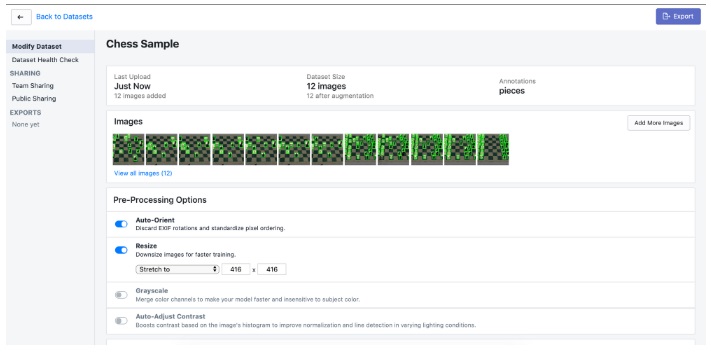The dashboard of Roboflow Organize.
Image provided by roboflow.ai
| WHO: Roboflow ESTABLISHED: August 2019 by second-time founders Brad Dwyer (previously Hatchlings) and Joseph Nelson (previously Represently) WHAT IT DOES: “Roboflow is a tool that developers use to build computer vision applications faster,” Nelson said. The problem that Brad Dwyer and Joseph Nelson started with didn’t seem quite so big. Along with Valley High School intern Jim Su, the team wanted to bring artificial intelligence to real-life board game enthusiasts, starting with the Boggle board. The resulting app, BoardBoss, gives players an opportunity to have augmented reality scan their board and review their game scores — but the development process was a bit of a headache. “In order to train a computer vision algorithm, you need to label a bunch of images. So we took a bunch of pictures of Boggle games, put boxes around all of the letters, labeled what the letters were,” co-founder Dwyer said. “We had trouble coordinating with each other — who had labeled what, what the status of things were. We were cropping some of the images, so trying to figure out what the first version [was], in a team of three people, was really hard.” It was like the days before Dropbox for sharing office files, he added: “You’d email files back and forth, and it’d be [file titles] like ‘D1.final.reallyfinal.txt’ or whatever, instead of just having this cloud storage system.” Computer vision applications will have a major role in future consumer and business technologies, Dwyer and Nelson said: It’s the technology behind mobile check deposits from a bank’s smartphone app, and what the Postal Service uses to scan addresses. “There’s going to be a whole Cambrian explosion of new things that computers can do because computer vision is becoming accessible,” Dwyer said. The current cloud storage services that the team patchworked up weren’t working well enough to handle BoardBoss file-sharing needs. Dwyer and Nelson realized if their development team was building its own tools to solve the issue, other computer vision teams — working on anything from X-ray analysis to self-driving vehicles — had to be doing the same thing. Enter Roboflow Organize, a web application designed to streamline image datasets and annotations for developers. “Each individual engineer or data scientist is writing their own Python script to do all these mundane tasks, and what they should be focusing on is the core, domain-specific parts of the problem — actually making the tractor self-driving, or actually identifying what’s a weed and what’s a plant,” Dwyer said. “There should be an infrastructure layer. … What we’re doing is making sure that these highly paid data scientists and engineers at these big companies can focus on the problem they’re actually solving, rather than writing their own kind of hacky infrastructure around it.” Developers who need to manage hundreds of images labeled for machine learning upload them as datasets into Roboflow, where they can apply pre-processing filters — photo filters, essentially — to take variables such as color out of the equation as their program learns to identify the labeled factor that developers want it to learn. “You can imagine if [developers] train their machine learning model on color images, and they trained it on a bunch of blue buttons. When it saw a green button it wouldn’t know what to do about that, because it’s only been trained on blue buttons,” Nelson noted. “Grayscale is one way where you can tell it, ‘Color is not important to this problem.’” Roboflow is leading an ongoing global remote accelerator contest known as Pioneer.app — as of Jan. 22, roboflow.ai is listed as the No.1 contestant out of the top 30 rankings. Dwyer and Nelson have previously won Pioneer’s funding tournament, which awarded BoardBoss $7,000 in cash, $200,000 in credits for cloud web services and a trip to Silicon Valley to meet investors. Roboflow Organize is being built to support datasets of about 143 gigabytes, which Dwyer called a current benchmark for machine learning algorithms. Nine weeks after the company was founded, Roboflow has two paying customers and is pitching the product to Fortune 500 companies. “I think there’s more to build as we understand more of what their problems are. I think they’ll have unique problems that we don’t even know about yet, so we can onboard them under our platform now — I think it’ll only become more valuable to them over time,” Dwyer said. |
Editor’s note: This story features an updated video link in the introduction.
